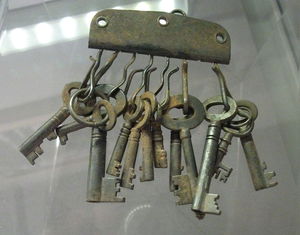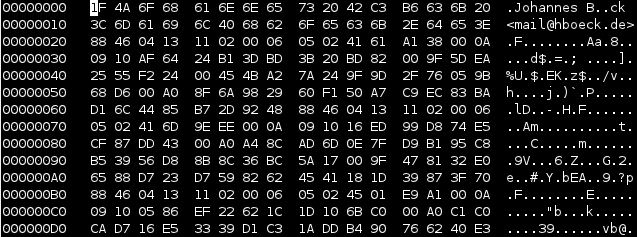Entries tagged as keyserver
Related tags
cryptography aiglx algorithm android apache apt badkeys braunschweig browser bsideshn ca cacert ccc cccamp cccamp15 certificate certificates chrome chromium cloudflare cmi compiz crash crypto darmstadt datenschutz deb debian dell deolalikar diffiehellman diploma diplomarbeit easterhegg edellroot eff email encryption english enigma facebook fedora fortigate fortinet forwardsecrecy gentoo gnupg gpg gsoc hannover hash http https itsecurity javascript key keyexchange leak letsencrypt libressl linux maninthemiddle math md5 milleniumproblems mitm modulobias mrmcd mrmcd101b nginx nist nss observatory ocsp ocspstapling openbsd openid openidconnect openpgp openssl packagemanagement papierlos password pgp pnp privacy privatekey provablesecurity pss random rc2 revocation revoke rpm rsa rsapss schlüssel security server sha1 sha2 sha256 sha512 signatures slides smime ssl sso stuttgart superfish talk thesis tls transvalid ubuntu unicode university updates utf-8 verschlüsselung vulnerability web websecurity windowsxp wordpress x509 factoring aok gajim jabber otr xmpp certificateauthority copyright licenses mysmartgrid publicdomain rsaoaep symantecSunday, May 17. 2015
About the supposed factoring of a 4096 bit RSA key
 tl;dr News about a broken 4096 bit RSA key are not true. It is just a faulty copy of a valid key.
tl;dr News about a broken 4096 bit RSA key are not true. It is just a faulty copy of a valid key.Earlier today a blog post claiming the factoring of a 4096 bit RSA key was published and quickly made it to the top of Hacker News. The key in question was the PGP key of a well-known Linux kernel developer. I already commented on Hacker News why this is most likely wrong, but I thought I'd write up some more details. To understand what is going on I have to explain some background both on RSA and on PGP keyservers. This by itself is pretty interesting.
RSA public keys consist of two values called N and e. The N value, called the modulus, is the interesting one here. It is the product of two very large prime numbers. The security of RSA relies on the fact that these two numbers are secret. If an attacker would be able to gain knowledge of these numbers he could use them to calculate the private key. That's the reason why RSA depends on the hardness of the factoring problem. If someone can factor N he can break RSA. For all we know today factoring is hard enough to make RSA secure (at least as long as there are no large quantum computers).
Now imagine you have two RSA keys, but they have been generated with bad random numbers. They are different, but one of their primes is the same. That means we have N1=p*q1 and N2=p*q2. In this case RSA is no longer secure, because calculating the greatest common divisor (GCD) of two large numbers can be done very fast with the euclidean algorithm, therefore one can calculate the shared prime value.
It is not only possible to break RSA keys if you have two keys with one shared factors, it is also possible to take a large set of keys and find shared factors between them. In 2012 Arjen Lenstra and his team published a paper using this attack on large scale key sets and at the same time Nadia Heninger and a team at the University of Michigan independently also performed this attack. This uncovered a lot of vulnerable keys on embedded devices, but these were mostly SSH and TLS keys. Lenstra's team however also found two vulnerable PGP keys. For more background you can watch this 29C3 talk by Nadia Heninger, Dan Bernstein and Tanja Lange.
PGP keyservers have been around since quite some time and they have a property that makes them especially interesting for this kind of research: They usually never delete anything. You can add a key to a keyserver, but you cannot remove it, you can only mark it as invalid by revoking it. Therefore using the data from the keyservers gives you a large set of cryptographic keys.
Okay, so back to the news about the supposedly broken 4096 bit key: There is a service called Phuctor where you can upload a key and it'll check it against a set of known vulnerable moduli. This service identified the supposedly vulnerable key.
The key in question has the key id e99ef4b451221121 and belongs to the master key bda06085493bace4. Here is the vulnerable modulus:
c844a98e3372d67f 562bd881da8ea66c a71df16deab1541c e7d68f2243a37665 c3f07d3dd6e651cc d17a822db5794c54 ef31305699a6c77c 043ac87cafc022a3 0a2a717a4aa6b026 b0c1c818cfc16adb aae33c47b0803152 f7e424b784df2861 6d828561a41bdd66 bd220cb46cd288ce 65ccaf9682b20c62 5a84ef28c63e38e9 630daa872270fa15 80cb170bfc492b80 6c017661dab0e0c9 0a12f68a98a98271 82913ff626efddfb f8ae8f1d40da8d13 a90138686884bad1 9db776bb4812f7e3 b288b47114e486fa 2de43011e1d5d7ca 8daf474cb210ce96 2aafee552f192ca0 32ba2b51cfe18322 6eb21ced3b4b3c09 362b61f152d7c7e6 51e12651e915fc9f 67f39338d6d21f55 fb4e79f0b2be4d49 00d442d567bacf7b 6defcd5818b050a4 0db6eab9ad76a7f3 49196dcc5d15cc33 69e1181e03d3b24d a9cf120aa7403f40 0e7e4eca532eac24 49ea7fecc41979d0 35a8e4accea38e1b 9a33d733bea2f430 362bd36f68440ccc 4dc3a7f07b7a7c8f cdd02231f69ce357 4568f303d6eb2916 874d09f2d69e15e6 33c80b8ff4e9baa5 6ed3ace0f65afb43 60c372a6fd0d5629 fdb6e3d832ad3d33 d610b243ea22fe66 f21941071a83b252 201705ebc8e8f2a5 cc01112ac8e43428 50a637bb03e511b2 06599b9d4e8e1ebc eb1e820d569e31c5 0d9fccb16c41315f 652615a02603c69f e9ba03e78c64fecc 034aa783adea213b
In fact this modulus is easily factorable, because it can be divided by 3. However if you look at the master key bda06085493bace4 you'll find another subkey with this modulus:
c844a98e3372d67f 562bd881da8ea66c a71df16deab1541c e7d68f2243a37665 c3f07d3dd6e651cc d17a822db5794c54 ef31305699a6c77c 043ac87cafc022a3 0a2a717a4aa6b026 b0c1c818cfc16adb aae33c47b0803152 f7e424b784df2861 6d828561a41bdd66 bd220cb46cd288ce 65ccaf9682b20c62 5a84ef28c63e38e9 630daa872270fa15 80cb170bfc492b80 6c017661dab0e0c9 0a12f68a98a98271 82c37b8cca2eb4ac 1e889d1027bc1ed6 664f3877cd7052c6 db5567a3365cf7e2 c688b47114e486fa 2de43011e1d5d7ca 8daf474cb210ce96 2aafee552f192ca0 32ba2b51cfe18322 6eb21ced3b4b3c09 362b61f152d7c7e6 51e12651e915fc9f 67f39338d6d21f55 fb4e79f0b2be4d49 00d442d567bacf7b 6defcd5818b050a4 0db6eab9ad76a7f3 49196dcc5d15cc33 69e1181e03d3b24d a9cf120aa7403f40 0e7e4eca532eac24 49ea7fecc41979d0 35a8e4accea38e1b 9a33d733bea2f430 362bd36f68440ccc 4dc3a7f07b7a7c8f cdd02231f69ce357 4568f303d6eb2916 874d09f2d69e15e6 33c80b8ff4e9baa5 6ed3ace0f65afb43 60c372a6fd0d5629 fdb6e3d832ad3d33 d610b243ea22fe66 f21941071a83b252 201705ebc8e8f2a5 cc01112ac8e43428 50a637bb03e511b2 06599b9d4e8e1ebc eb1e820d569e31c5 0d9fccb16c41315f 652615a02603c69f e9ba03e78c64fecc 034aa783adea213b
You may notice that these look pretty similar. But they are not the same. The second one is the real subkey, the first one is just a copy of it with errors.
If you run a batch GCD analysis on the full PGP key server data you will find a number of such keys (Nadia Heninger has published code to do a batch GCD attack). I don't know how they appear on the key servers, I assume they are produced by network errors, harddisk failures or software bugs. It may also be that someone just created them in some experiment.
The important thing is: Everyone can generate a subkey to any PGP key and upload it to a key server. That's just the way the key servers work. They don't check keys in any way. However these keys should pose no threat to anyone. The only case where this could matter would be a broken implementation of the OpenPGP key protocol that does not check if subkeys really belong to a master key.
However you won't be able to easily import such a key into your local GnuPG installation. If you try to fetch this faulty sub key from a key server GnuPG will just refuse to import it. The reason is that every sub key has a signature that proves that it belongs to a certain master key. For those faulty keys this signature is obviously wrong.
Now here's my personal tie in to this story: Last year I started a project to analyze the data on the PGP key servers. And at some point I thought I had found a large number of vulnerable PGP keys – including the key in question here. In a rush I wrote a mail to all people affected. Only later I found out that something was not right and I wrote to all affected people again apologizing. Most of the keys I thought I had found were just faulty keys on the key servers.
The code I used to parse the PGP key server data is public, I also wrote a background paper and did a talk at the BsidesHN conference.
Posted by Hanno Böck
in Code, Cryptography, English, Linux
at
22:46
| Comments (13)
| Trackbacks (4)
Tuesday, December 14. 2010
How I revoked my old PGP key
Prologue of this story: A very long time ago (2004 to be exact), I decided to create a new PGP / GnuPG key with 4096 bits (due to this talk). However, shortly after that, I had a hardware failure of my hard disc. The home was a dm-crypt partition with xfs. I was able to restore most data, but it seemed the key was lost. I continued to use my old key I had in a backup and the 4096 key was bitrotting on keyservers. And that always annoyed me. In the meantime, I found all private keys of old DOS (2.6.3i) and Windows (5.0) PGP keys I had created in the past and revoked them, but this 4096 key was still there.
I still have the hard disc in question and a couple of dumps I created during the data rescue back then. Today, I decided that I'll have to try restoring that key again. My strategy was not trying to do anything on the filesystem, but only operate within the image. Very likely the data must be there somewhere.

I found a place where I was rather sure that this must be the key. But exporting that piece with dd didn't succeed - looking a bit more at it, it seemed that the beginning was in shape, but at some place there were zeros. I don't know if this is due to the corruption or the fact that the filesystem didn't store the data sequentially at that place - but it didn't matter. I had a look at the file format of PGP keys in RFC 4880. Public keys and private keys are stored pretty similar. Only the beginning (the real "key") part differs, the userid / signatures / rest part is equal. So I was able to extract the private key block (starting with 0x95) with the rest (I just used the place where the first cleartext userid started with my name "Johannes"). What should I say? It worked like a charm. I was able to import my old private key and was able to revoke it. Key 147C5A9F is no longer valid. Great!
P. S.: Next step will be finally creating a new 4096 bit RSA key and abandoning my still-in-use 1024 bit DSA key for good.
I still have the hard disc in question and a couple of dumps I created during the data rescue back then. Today, I decided that I'll have to try restoring that key again. My strategy was not trying to do anything on the filesystem, but only operate within the image. Very likely the data must be there somewhere.

I found a place where I was rather sure that this must be the key. But exporting that piece with dd didn't succeed - looking a bit more at it, it seemed that the beginning was in shape, but at some place there were zeros. I don't know if this is due to the corruption or the fact that the filesystem didn't store the data sequentially at that place - but it didn't matter. I had a look at the file format of PGP keys in RFC 4880. Public keys and private keys are stored pretty similar. Only the beginning (the real "key") part differs, the userid / signatures / rest part is equal. So I was able to extract the private key block (starting with 0x95) with the rest (I just used the place where the first cleartext userid started with my name "Johannes"). What should I say? It worked like a charm. I was able to import my old private key and was able to revoke it. Key 147C5A9F is no longer valid. Great!
P. S.: Next step will be finally creating a new 4096 bit RSA key and abandoning my still-in-use 1024 bit DSA key for good.
Posted by Hanno Böck
in Code, Computer culture, Cryptography, English, Linux, Security
at
15:47
| Comment (1)
| Trackbacks (0)
(Page 1 of 1, totaling 2 entries)